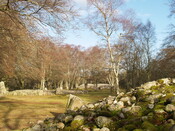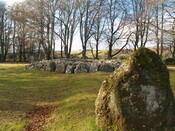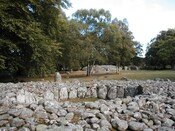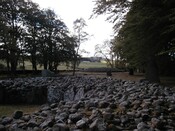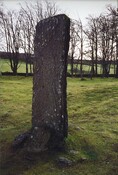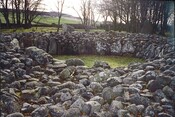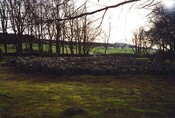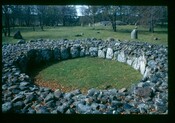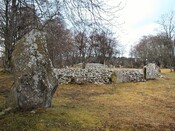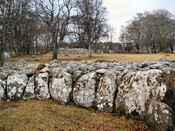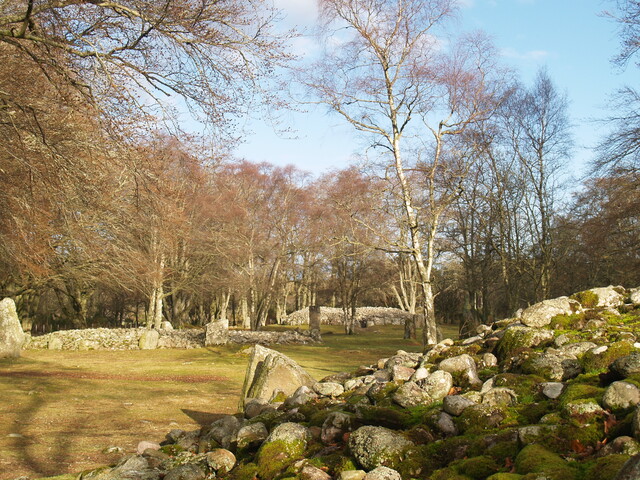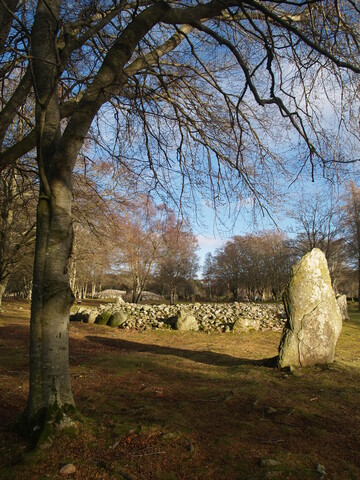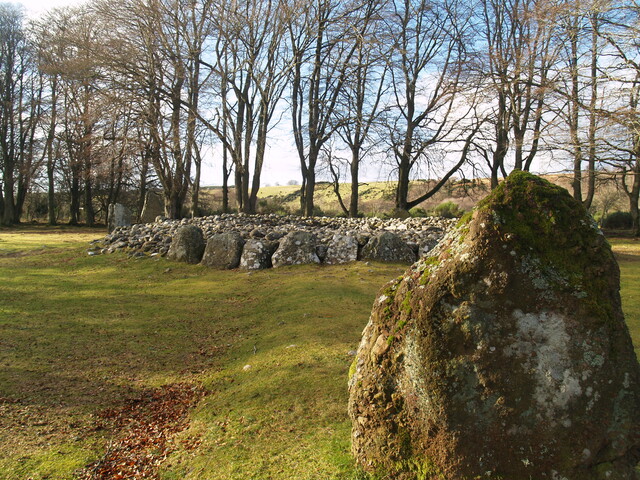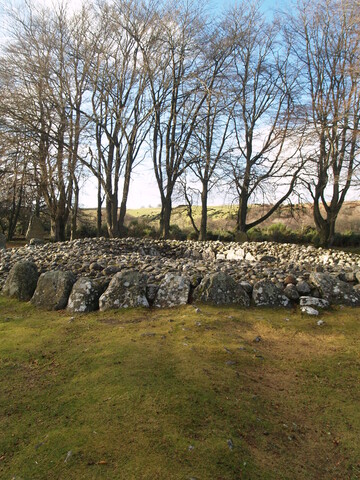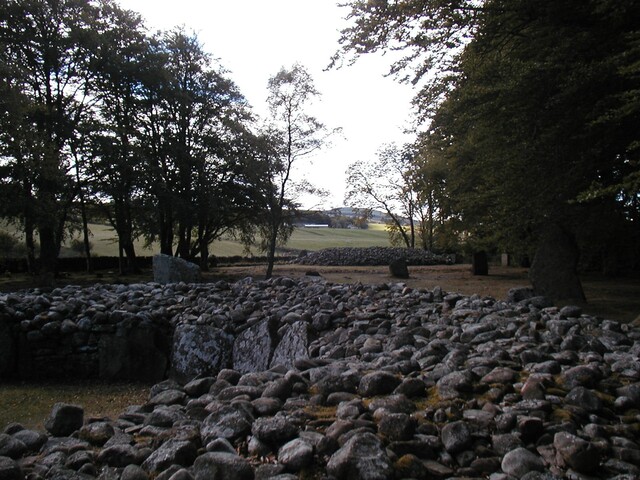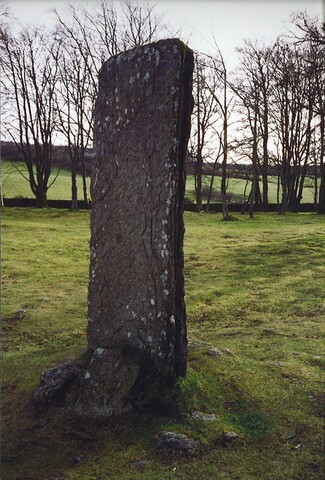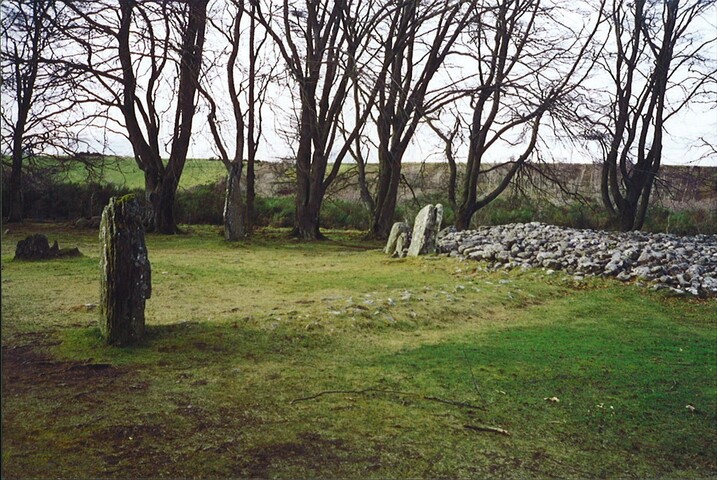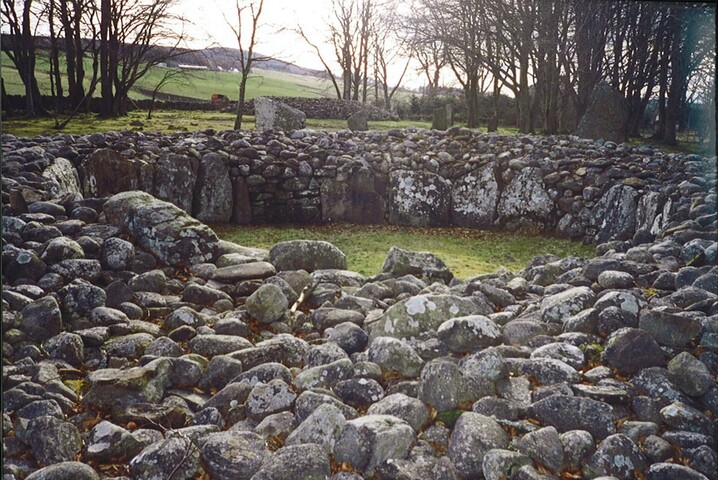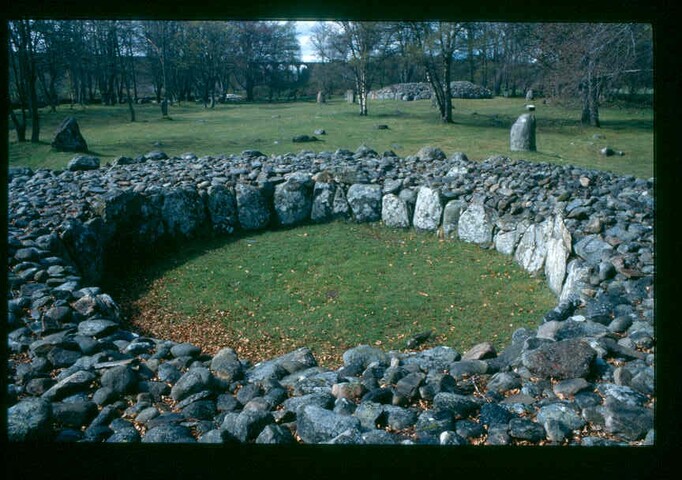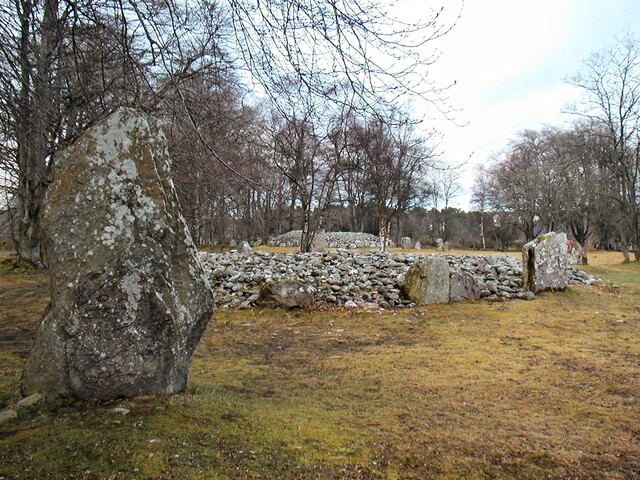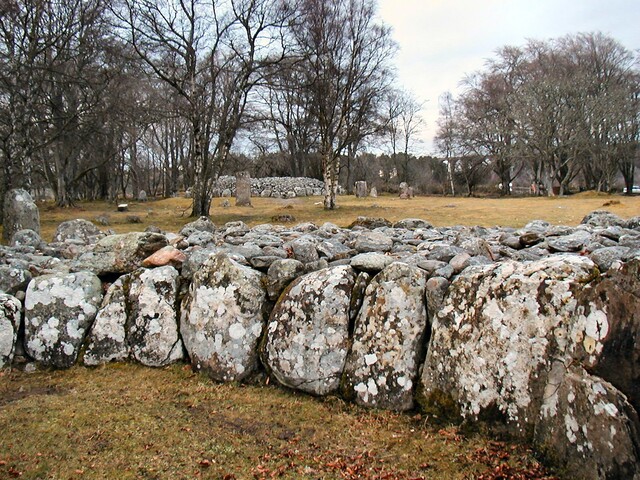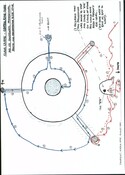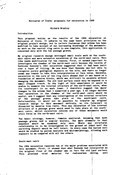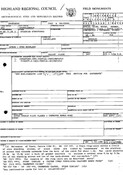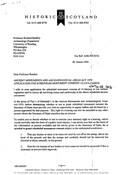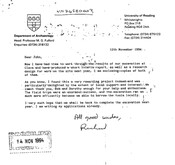MHG4366 - Central ring cairn - Balnuaran of Clava
Summary
Ring cairn at Balnuaran of Clava.
Type and Period (1)
Protected Status
Full Description
The central ring cairn at Clava.
(Centred NH 7571 4443) Stone Circles and Cairns (NR) (Urns containing calcined bones found)
OS 6"map, Inverness-shire, 2nd ed., (1906)
This ring cairn is between the two passage-graves at Balnuaran, the standing stones encircling these sites being only 80 and 123 feet from the monolithic circle of this cairn. All three sites were restored by the owner about 1881 (Jolly 1882).
The kerb of the cairn encloses a slightly oval area measuring 60 by 52 feet. It is built of massive boulders but is now very imperfect on the south side. On the south-south-west opposite the stump of a monolith is the most notable of the kerb-stones, a great rectangular block 4 feet 3 inches high, its neighbouring stones to the west are only 2 feet and 2 feet 10 inches high. The cairn material is heaped up to a height of about 4 feet inside the kerb. Cairn material also extends for about 5 feet outside the kerb as a low grass-grown bank. A small area against the outside of the kerb on the south-south-west side was examined in 1953 but nothing was found except a small patch of charcoal on the old surface.
The central area is defined by a setting of flat slabs (in contrast to the boulders of the kerb, 2 feet 9 inches to 3 feet 6 inches high, which enclose an almost circular space 21 by 18 feet.
The cairn is surrounded by nine monoliths set 25 to 21 feet outside the kerb, with an overall diameter of about 100 feet. The tallest stone remaining is on the west-south- west and is 7 feet 6 inches high. Four of the monoliths, three on the south to south-west arc and one on the east-north-east, were re-erected at the "restoration" (Jolly 1882). Three of the monliths, are connected to the kerb by distinct "causeways" 6 to 8 feet wide and at least 1 foot high. When examined in 1953 they were found to consist of "small boulders carefully packed to form a slightly convex strip" (Piggott 1956). These causeways are a unique feature, there being on trace of them at any Clava-type site.
The monolith on the south-east side is reputed to be cup-marked (Jolly 1882) on it outer side, but it is much weathered and only one cup-marked can now be made out, and that without much confidence. The monolith at the end of the west causeway is also reported as marked, but these are due to weathering. Of the two adjacent cupmarked stones on the east-south-east side of the kerb, one is very weathered and is uncertain, the other is about 3 feet high and is in a leaning position mainly covered with turf. Under the turf can be seen very distinct cup-marks as illustrated (Jolly 1882) except that the channel indicated seems to be a natural crack. Some rough flakes of pebble flint have been found in the central areas (Piggott 1884).
C Innes 1862; W Jolly 1882; J Fraser 1884; S Piggott 1956; A S Henshall 1963, visited 16.4.57
The cairn was Scheduled with the adjacent cairns in 1882.
NH 7571 4443 The remains of the ring-cairn are as described above. Revised at 1/2500.
Visited by OS (W D J) 25 April 1962.
Air photographs of the Balnuaran of Clava cairns, taken by Jill Harden in 1989, are in Inverness Museum (8901.21-22 and 8907.02 INVMG). Information from J Harden 1989.
NH74SE 4 (SW cairn) and central cairn: The 1994 excavation at Balnuaran of Clava had three main aims. First, it sought to identify how far the site has changed its appearance as a result of modem restoration of the monument. A main focus was the largely unpublished excavation of 1930-31. Two of these trenches were reopened and other work was carried out on the SW passage grave. This showed that the chamber 'floor' identified in that work was in fact the old land surface beneath the monument. Both there and at the central ring caim excavation had extended into the natural fluvio-giacial gravel, In the case of the central ring cairn unrecorded excavation around the end of the last century had resulted in the clearance of the interior. The rubble removed from that part of the site was added to the material of the cairn.
Second, it sought to resolve the structural sequence at both monuments. At the SW cairn the external ramp was of a single phase. It had been built simultaneously with the kerbstones, which lacked any sockets. At the central ring cairn, there is evidence that the cairn, the stone circle and the external rays which connect these features together were all built at the same time. The line of at least one of the rays seems to have perpetuated division in the internal construction of the ring cairn. In between its kerb and the circle of monoliths was a setting of flat slabs overlying an unaccompanied cremation- This formed the focus for a distribution of pieces of worked flint and quartz.
Third, it aimed to obtain radiocarbon samples. Four such samples were collected, from the old land surfaces beneath each of the cairns, from the cremation outside the central ring cairn and from the socket of one of the monoliths enclosing that site.
Sponsors: Society of Antiquaries of Scotland, British Academy, Society of Antiquaiies of London, with considerable help in kind from Historic Scotland, Highland Regional Council and Reading University.
Bradley 1994.
Site visited and photographed by Angela Lake, 23/9/2003. The Highland Archaeology Challenge. See Assoc. Docs. File for notes and plan.
J Aitken : 22/1/2004
The monument was re-scheduled by Historic Environment Scotland in 2016. <1> <2>
Radiocarbon dates were obtained as part of the archaeological investigations by Bradley, and were published in his 2000 publication. They suggest that the cairn was in use in the Early Bronze Age. <1>
See separate record MHG63104 for cup marked stone.
Sources/Archives (27)
- --- SHG12489 Image/Photograph(s): Balnuaran of Clava, Ring Carin.. Colour Slide; Digital Image. .
- --- SHG12490 Image/Photograph(s): Clava Ring Cairn.. Colour Slide; Digital Image. .
- --- SHG1251 Text/Publication/Article: Innes, C. 1862. 'Notice of a tomb on the hill of Roseisle, Morayshire, recently opened; also of the chambered cairns and stone circles at Clava, in Nairnshire', Proc Soc Antiq Scot Vol. 3 1857-60, p.46-50. Proc Soc Antiq Scot. 46-50. 50.
- --- SHG1317 Text/Publication/Article: Jolly, W. 1882. On cup-marked stones in the neighbourhood of Inverness; with an appendix on cup-marked stones in the Western Islands. Proc Soc Antiq Scot Volume 16. 300-401. 305-9.
- --- SHG1422 Text/Publication/Article: Ritchie and MacLaren, J N G and A. 1973. 'Ring-cairns and related monuments in Scotland', Scot Archaeol Forum Vol. 4 1972, p.1-17. Scot Archaeol Forum. 1-17. 8.
- --- SHG1544 Text/Publication/Article: Burl, {H} A {W}. 1973. 'Stone circles and ring-cairns', Scot Archaeol Forum Vol. 4 1972, p.31-47. Scot Archaeol Forum. 31-47. 31-47.
- --- SHG1638 Text/Publication/Article: Walker, I C. 1965. 'The Clava cairns', Proc Soc Antiq Scot Vol. 96 1962-3, p.87-106. Proc Soc Antiq Scot. 87-106. 87-106.
- --- SHG1639 Text/Publication/Article: Barclay, G J. 1991. 'The clearing and partial excavation of the cairns at Balnuaran of Clava, Inverness-shire, by Miss Kathleen Kennedy, 1930-31', Proc Soc Antiq Scot Vol. 120 1990, p.17-32. Proc Soc Antiq Scot. 17-32. 21; illus 3.
- --- SHG1711 Text/Publication/Article: Burl, H A W. 1973. 'The recumbent stone circles of North-East Scotland', Proc Soc Antiq Scot Vol. 102 1969-70, p.56-81. Proc Soc Antiq Scot. 56-81. 73, 77.
- --- SHG2003 Text/Publication/Volume: Burl, {H} A {W}. 1979. Rings of stone: the prehistoric stone circles of Britain and Ireland. 126-9.
- --- SHG2004 Text/Publication/Volume: Burl, {H} A {W}. 1976. The stone circles of the British Isles. 161, 165-7, 177, 226, 358.
- --- SHG2053 Text/Publication/Volume: Close-Brooks, J. 1986. Exploring Scotland's Heritage: The Highlands. 162, No. 91.
- --- SHG256 Text/Publication/Article: Bradley, R. 1994. 'Balnuaran of Clava (Croy & Dalcross parish): megalithic cemetery', Discovery and Excavation in Scotland 1994, p.34-5. Discovery and Excavation in Scotland. 34-5. 34-35; fig 16.
- --- SHG25827 Image/Photograph(s): Puls, A. 2008. Clava Cairns. Highland Council Planning & Development Service.
- --- SHG2673 Text/Report: RCAHMS. 1979. The Royal Commission on the Ancient and Historical Monuments of Scotland. The archaeological sites and monuments of North-east Inverness, Inverness District, Highland Region. . 7, No. 5 (3).
- --- SHG2867 Text/Publication/Volume: Thom, A. 1967. Megalithic sites in Britain. 64, 65, 69, 98, 137, no. B7/1.
- --- SHG3124 Text/Publication/Article: Burl, H A W. 1982. Pi in the sky. SHG23368. 141-9. 150.
- --- SHG3128 Text/Publication/Article: Burl, H A W. 1981. "By the light of the cinerary moon": chambered tombs and the astronomy of death. SHG23416. 243-74. 257.
- --- SHG315 Collection/Catalogue/Gazetteer: Thom, Thom and Burl, A, A S and [H] A [W]. 1980. Megalithic rings: plans and data for 229 monuments in Britain. 81. 246-7.
- --- SHG357 Text/Publication/Monograph: Henshall, A S. 1963. The chambered tombs of Scotland, Volume 1. 361-2, INV 8.
- --- SHG5028 Image/Photograph(s)/Aerial Photograph: B/W Negative. .
- --- SHG537 Text/Publication/Article: Fraser, J. 1884. 'Descriptive notes on the stone circles of Strathnairn and neighbourhood of Inverness', Proc Soc Antiq Scot Vol. 18 1883-4, p.328-62. Proc Soc Antiq Scot. 328-62. 348-50.
- --- SHG7428 Image/Photograph(s): Clava, Balnuaran. Digital Image. .
- --- SHG749 Text/Publication/Article: Piggott, S. 1956. Excavations in passage-graves and ring-cairns of the Clava group 1952-3. Proc Soc Antiq Scot Volume 88. 173-207. 188-90.
- <1> SHG23271 Text/Publication/Monograph: Bradley, R. et al. 2000. The Good Stones: a new investigation of the Clava Cairns. Society of Antiquaries of Scotland Monograph Series. 17. Paper (Original) & Digital. pp 18-23, 50-59, 115-119.
- <1> SHG27658 Text/Designation Notification/Scheduled Monument: MacIver, M.. 2016. Changes to the schedule of Monuments 27/09/2016. Historic Environment Scotland. Digital.
- <2> SHG27701 Text/Designation Notification/Scheduled Monument: Historic Environment Scotland. 2016. Amended entry in the Schedule of Monuments: SM90074: Clava Cairns, cairns 70m, 170m NE of and 210m, 460m ENE of, barrow 270m NE of, and standing stone 395m NE of Balnuarin. Historic Environment Scotland. Digital.
Map
Location
| Grid reference | Centred NH 7571 4443 (40m by 40m) (2 map features) |
|---|---|
| Map sheet | NH74SE |
| Civil Parish | CROY AND DALCROSS |
| Geographical Area | INVERNESS |
Finds (0)
Related Monuments/Buildings (0)
Related Investigations/Events (0)
External Links (2)
- http://portal.historicenvironment.scot/designation/SM90074 (Online designation description (Historic Environment Scotland))
- https://canmore.org.uk/site/14277 (View HES Canmore entry for this site)
Comments and Feedback
Do you have any more information about this record? Please feel free to comment with information and photographs, or ask any questions, using the "Disqus" tool below. Comments are moderated, and we aim to respond/publish as soon as possible.
